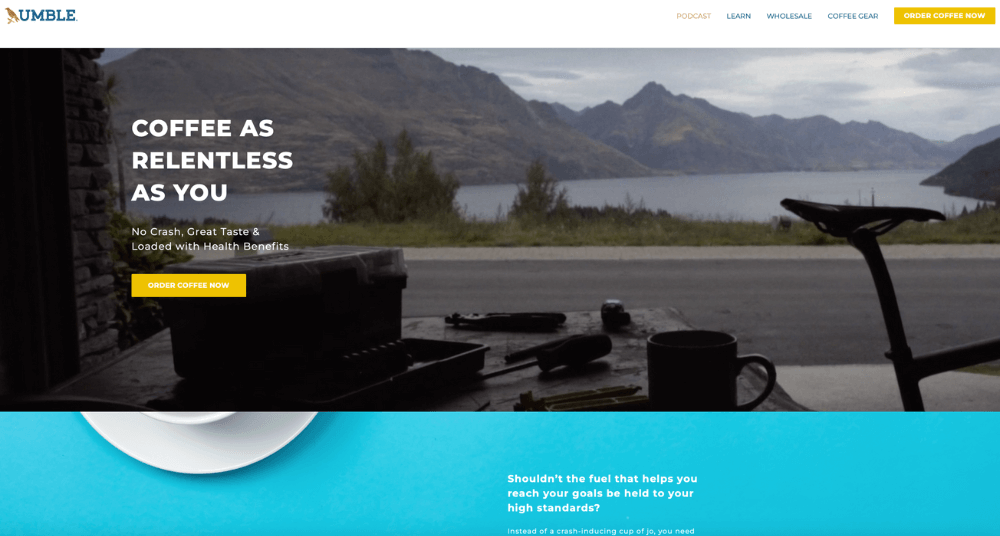
Improve Your Website With The StoryBrand Framework & Other Copywriting Tactics
Writing great website copy doesn’t need to be complicated, but it does require a thoughtful focus on customers - here’s how to get it right.
“We’re the number one seller in our industry.” “We have more than $10m in sales annually.” “Our products aren’t like anything else on the market today.” So many business websites lead with statements like these. They want to tell you how their company, or product, or leaders, are the best in the business.
But the big secret of writing effective website copy is that people really don’t care. Yes, even your current and prospective customers. Sounds a bit harsh, but it’s true. We live in a world where the human brain is bombarded with marketing constantly, and most of it sounds like a whole lot of chest-thumping and bragging.
Of course, that’s not what the people writing the messages mean to do. They’re simply proud of the company and its products and are excited to share that information with customers. While this urge is understandable, it is not going to help you sell more.
What will help you? If your copywriting focuses on making it all about the customer’s favorite person in the whole world: themself.
This is where the StoryBrand framework comes to the rescue. Donald Miller created it in his best-selling book Building a StoryBrand. And it has become the go-to for many business owners who want to write copy that sells.
In this article, we will break down exactly what you can learn from StoryBrand, and how to implement similar strategies for your own ecommerce store.
What is the StoryBrand Framework?
StoryBrand has an incredibly simple and wildly effective seven-step framework for developing your marketing plan or marketing message.
- Begin with the hero of the story—your customer—and what they want. Keep it clear with a single thing customers want from your brand.
- Define your customer’s problem—the problem you can solve for them. People are looking at what you offer because they have a pain point or an issue they need a solution for, and you need to understand it to sell them that solution.
- Position yourself as the customer’s guide, not their hero. Don’t talk about what your business is trying to do, but do tell them how what you sell will help them win their next battle.
- Give them a simple three-step roadmap for success. Your visitor probably isn’t ready to buy now, but you can show them how easy it will be to work with you when they’re ready for that step.
- Call them to take an action, like buying now or signing up for a call from your sales team. Your CTA should be clear and prominent on your site so customers know exactly what you want them to do.
- Tell them how you’ll help them avoid failure by painting a picture of what negative consequences they will face without you as their trusted guide. You need to tell them what’s at stake in this purchase decision.
- Finally, show them what success looks like once they partner with you. This is where you paint them a picture with your website copy and images that show them what their life will look like when their problem is solved.
This is a broad overview of what the StoryBrand framework looks like in practice—for an in-depth discussion of everything that goes into those stages, check out the official StoryBrand website.
And we’ve got a breakdown of exactly what each of these steps looks like for an ecommerce company coming below.
Why the StoryBrand 7-Part Framework Works
Another simple way to break down the StoryBrand formula into a marketing strategy you can use is this three-step process.
You can see here that the path to writing great website copy begins by thinking about the customer’s needs. Who are they, what pain are they currently experiencing, and how do they dream it will be resolved?
This framing is effective because it focuses on the customer, not the business. If you want customers to listen to you, you need to talk about them (don’t we always love to hear people talk about us?)
And it’s not just about speaking to their ego—it also lets them know that you understand their internal problem and external problems, which builds trust. That’s why the StoryBrand approach works.
The Power of Stories
The other reason StoryBrand is such an effective way to look at your marketing copy is right in the name—it tells a good story. Humans are innately drawn to stories over a list of accolades, testimonials and facts.
That’s why we love movies like Gladiator. You probably can’t name many other Roman emperors or their successors, but the compelling world that the film creates around its historical characters make Ancient Rome come alive in a wholly memorable way—and so we can talk conversationally about Marcus Aurelius and his son Commodus.
This is the effect you want your website copy to have on your audience. They should feel connected to your story, see themselves in it, and want to learn more about what you can help them do.
Enjoying this article?
Subscribe to our newsletter, Good Question, to get insights like this sent straight to your inbox every week.
Telling Your Story for Ecommerce Brands
StoryBrand is powerful, but it’s not a magic bullet—it is simply an easy-to-use framework that you can learn from when you’re writing your website copy.
And there are some differences that ecommerce brands need to know specifically. The StoryBrand framework is directed primarily at service-based businesses that provide a single service.
For ecommerce businesses that sell multiple products, you will need to adjust the classic framework to your particular circumstances.
Instead of working to keep your website visitors on your homepage, for example, you will want to write copy that encourages them to go to your product pages. Those product pages should each tell the story of a different problem, and how the product solves it.
You’ll also want to be sure you’re featuring the most exciting products on your home page to encourage users to go there right away. Don’t distract them with a lot of content about your business upfront. Show them the goods!
Ecommerce businesses will also need to focus on the complete customer journey in the website more than a business offering a single service. Since you want your visitors to click on multiple product pages and then check out, all of those pages must load super fast, or you risk losing potential buyers.
No matter how great your copy is, you will also need a great customer experience to increase conversion rates.
The StoryBrand BrandScript for Ecommerce
It’s all well and good to tell you about the StoryBrand marketing framework—but what does it really look like? Let’s take a look at a hypothetical company that sells designer shoes online.
First, they would go through the seven StoryBrand steps and answer the questions there. This can be done by talking with people across their organization as well as customers. Consequently, those conversations about customers’ problems become important data. They are how you get the most accurate view of what your company does for, and means to, customers.
Here’s what the results of those conversations look like in the StoryBrand framework:
- The Hero: Their ideal customers are fashion-forward high-income young professionals. They want to stand out to their peers as the trendsetters they are through their footwear.
- The Pain Point: Their problem is that in a world with lots of expensive shoes to buy, they have trouble finding the unusual, avant-garde ones. They are busy with their jobs and don’t have time to spend searching in lots of retailers to find the shoes they want—which is not what everyone else has.
- The Guide: The designer or shoe retailer is their guide in this search, helping them stay on top of the latest international trends, all in one place with an exceptional customer experience.
- The Plan: The retailer has a plan for enticing new customers, as shown by two placements on their homepage: a selection of the latest new products, and a one or two-line overview of their concierge service that helps users find their size or style if it’s out of stock.
- The CTA: The call to action is that classic “Shop Now” button, floating prominently over a selection of the coolest shoe styles from around the world.
- The Vision of Failure: If the shopper doesn’t purchase from this brand, the copy suggests, they’ll be doomed to a life of wearing the same shoes as every other colleague in their office.
- The Picture of Success: Finish with images of delighted uber-trendy customers in their one-of-a-kind shoes strolling in their neighborhood on their way to some fabulous activity, and a brief tagline summarizing that feeling in words.
Once you’ve written out the answers to each of these steps, you have your BrandScript. It’s a concise way of describing how your business helps your customers live a better life. You can use it for your website copy or creating other marketing materials.
Of course, this is just a potential framework. You don’t need to follow every step to the letter. It’s an effective way of getting into the mindset of your potential customers when you write your website copy. You can still find ways to tell your brand story without hurting conversions—this is one way to do that.
StoryBrand Website Examples
Lund Leather’s website is a great StoryBrand ecommerce example. They use a clear CTA and minimalist but effective copywriting. Moreover, you’ll find great images of their products to draw in visitors and convert them to customers.

Umble Coffee also uses the StoryBrand guidelines for its website. It focuses the copy entirely on who the customer is and why this coffee is a solution to help them make their lives better.

Perfect Your Website Copy
The StoryBrand seven-step process helps business owners think through what their business provides for customers and helps them articulate that vision through their website copy.
Your website needs to talk about what matters to your customers in order to stand out from all the other marketing noise. If you can get that clear message right, you’re well on your way to increased conversions. This, in turn, means more successful ecommerce business.
Enjoying this article?
Subscribe to our newsletter, Good Question, to get insights like this sent straight to your inbox every week.

About the Author
James Sowers
James Sowers is the former Director of The Good Ventures. He has more than a decade of experience helping software and ecommerce companies accelerate their growth and improve their customer experience.